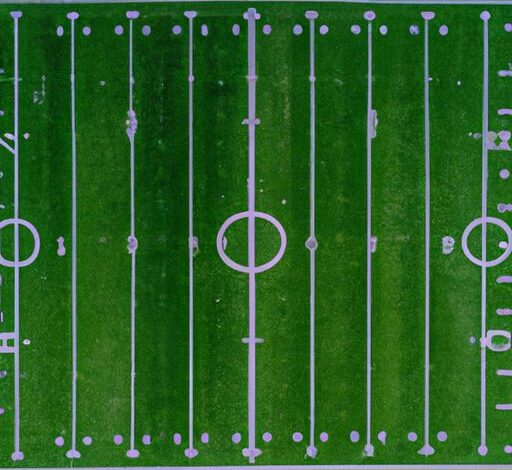How Many Yards on a Football Field? Understanding the Dimensions

Introduction
Have you ever watched a football game and wondered about the dimensions of the field? Understanding the measurements of a football field is crucial for both players and fans alike. In this article, we will delve into the importance of comprehending the dimensions of a football field and explore the main keyword, “how many yards on a football field,” to provide you with a comprehensive understanding.
When it comes to football, the field itself holds a significant role in shaping the game. From strategic gameplay to scoring opportunities, the dimensions of a football field play a vital part in every match. So, let’s uncover the secrets behind the yards on a football field.
Understanding the Dimensions of a Football Field
A football field is an expansive space where the magic of the game unfolds. The length of a football field is measured in yards and serves as a fundamental aspect of the game. By knowing the exact length, players can strategize their plays and anticipate the distance needed to gain yardage or score a touchdown.
Comparatively, a football field is longer than most other popular sports fields. This elongated expanse allows for thrilling plays and exciting action, providing ample room for players to showcase their skills. However, the length is just one part of the equation. The width of a football field also plays a crucial role in gameplay strategies, offering both offense and defense opportunities to outmaneuver their opponents.
Understanding the dimensions of a football field is the key to unlocking the mysteries of the game. By comprehending the length and width, players and fans alike can fully appreciate the intricacies of football and marvel at the strategies employed by teams.
Now that we have established the significance of understanding the dimensions of a football field, let’s explore the yard lines and yardage markers that further enhance the gameplay experience. Join me in the next section as we dive into the world of yard lines on a football field and their impact on the game.
Football Field Dimensions
Football fields are not just random patches of grass; they are meticulously measured and constructed to create an optimal playing environment. Understanding the dimensions of a football field provides insights into the intricacies of the game and enhances your appreciation for the sport.
A. Length of a Football Field
The length of a football field is an essential factor in determining the distance players must cover to achieve their objectives. In football, the field length is measured in yards, and it spans a considerable distance. But what exactly does this measurement signify?
To put it simply, a football field is 100 yards long. Yes, you heard it right, a whole 100 yards! That’s equivalent to the length of 300 feet or 91.44 meters. This vast expanse of green provides ample room for players to display their skills and engage in thrilling plays.
To put this into perspective, let’s compare a football field to other popular sports fields. A football field is longer than a soccer field, which typically ranges from 100 to 130 yards long. Additionally, it surpasses the length of a baseball outfield, typically measuring around 325 to 400 feet. The length of a football field truly stands out, showcasing the scale on which the game is played.
B. Width of a Football Field
While the length of a football field is impressive, the width should not be overlooked. The width of a football field plays a critical role in gameplay strategies, offering both offense and defense opportunities to outmaneuver their opponents.
A standard football field measures 53 1/3 yards wide, which is approximately 160 feet or 48.8 meters. This width provides ample space for players to execute their plays effectively and create strategic advantages. The broader field allows for wider running lanes and passing opportunities, enabling teams to employ various tactics to gain an advantage.
The width of a football field is not just a random measurement; it’s a strategic dimension that influences gameplay decisions. Understanding the significance of the width allows fans to appreciate the intricacies of the sport and witness the strategic maneuvers employed by teams.
Now that we have explored the dimensions of a football field, let’s move forward to the next section, where we will unravel the mysteries of yard lines and their impact on the game. Join me as we delve into the world of yard lines on a football field in Section
Yard Lines on a Football Field
Yard lines are the markings on a football field that serve as a crucial navigational tool for players and officials. These lines divide the field into segments, allowing for accurate measurement of yardage gained or lost during a play. Let’s explore the definition, purpose, and significance of yard lines in the game of football.
Definition and Purpose of Yard Lines
Yard lines are horizontal lines that run across the width of the football field, parallel to each other. These lines are spaced at regular intervals and are marked with numbers indicating the distance from each end zone. The purpose of yard lines is to provide a clear reference point for players, coaches, and officials to determine the current location on the field and track the progress of the game.
Explanation of the Markings on Yard Lines
-
Hash Marks: Hash marks are short parallel lines that extend inward from the sidelines toward the center of the field. They are positioned at one-yard intervals and are used to determine the placement of the ball for each play. These marks ensure that the ball is properly aligned for a fair and balanced game.
-
Sideline Numbers: Sideline numbers are large numerals that are positioned at regular intervals along the sidelines of the football field. These numbers indicate the yard line where the ball is currently placed, providing quick and easy reference points for players and officials.
-
50-Yard Line: The 50-yard line is a significant yard line in football, located exactly at the midpoint of the field. It serves as a dividing line, separating the field into two equal halves. The 50-yard line holds symbolic importance and is often associated with momentum shifts during the game.
Significance of Yard Lines in Gameplay
Yard lines play a pivotal role in gameplay, providing crucial information to players, coaches, and officials. By understanding the yard lines, teams can strategize and execute their plays effectively. The yard lines dictate the distance needed to achieve a first down or score a touchdown, influencing the tactics employed by both the offense and defense.
Furthermore, yard lines are essential for officials to make accurate calls regarding player positioning, penalties, and out-of-bounds rulings. The precise measurement of yardage gained or lost during a play relies on the yard lines, ensuring fair and consistent gameplay.
In conclusion, yard lines on a football field serve as essential markers that guide the flow of the game. From providing reference points for players and officials to influencing strategic decisions, these lines contribute to the excitement and precision of football. In the next section, we will explore the yardage markers on a football field and their role in tracking progress.
Yardage Markers on a Football Field
Yardage markers are essential elements on a football field that help players, coaches, and fans track the progress of a game. These markers provide reference points to measure the distance covered by the teams and determine the yardage remaining for a first down or touchdown. Let’s take a closer look at the different types of yardage markers found on a football field.
A. Explanation of Yardage Markers
-
Yardage Numbers on the Sideline:
Along the sidelines of a football field, you’ll find yardage numbers displayed at regular intervals. These numbers indicate the distance from the end zone, typically starting from 10 yards and counting down towards the goal line. They allow players to quickly assess the distance they need to gain or defend. -
Field Goal Post:
Another crucial yardage marker on a football field is the field goal post. Located at the back of the end zone, the field goal post serves as a reference point for scoring opportunities. It consists of two upright posts and a horizontal crossbar, where kickers aim to send the football through for a successful field goal or extra point.
B. Importance of Yardage Markers for Tracking Progress
Yardage markers play a vital role in tracking the progress of a football game. They provide a visual representation of the distance covered, allowing players to measure their performance and adjust their strategies accordingly. Coaches can use these markers to analyze their team’s progress and make informed decisions regarding play calling or defensive formations.
Furthermore, yardage markers are crucial for officials to determine whether a team has achieved a first down. The distance remaining for a first down is measured from the nearest yardage marker, ensuring fair and accurate gameplay. Additionally, yardage markers help fans understand the game better, allowing them to follow the action and cheer for their team as they advance towards the end zone.
In summary, yardage markers are more than just numbers on a football field. They serve as visual guides, tracking the progress of the game and enabling players, coaches, and fans to stay engaged. So, the next time you’re watching a football game, pay attention to these markers and appreciate their significance in the game’s dynamic nature.
Stay with me as we move on to explore additional measurements on a football field in the next section.
Additional Measurements on a Football Field
End Zones: Where Glory Awaits
One of the most thrilling aspects of a football field is the presence of end zones. These designated areas at each end of the field hold great significance and offer remarkable opportunities for both teams. Let’s explore the dimensions and the scoring potential of end zones.
1. Length and Width of End Zones
End zones are rectangular spaces located at the far ends of the football field. They are typically 10 yards deep and extend the width of the field. This means that each end zone measures 53.33 feet in length. Understanding the dimensions of end zones is crucial for players to strategize their offensive and defensive maneuvers.
2. Scoring Opportunities in End Zones
End zones are where dreams become reality and touchdowns are celebrated in jubilation. When a player successfully carries the ball or catches a pass while crossing into the end zone, it results in a touchdown, the ultimate scoring achievement in football. The scoring team is awarded 6 points, and they have the option to earn an additional point by kicking the ball through the uprights on a field goal attempt or 2 points by successfully completing a play from a closer distance. End zones are the battlegrounds for glory, making them a focal point of every football game.
Goal Line: The Boundary of Triumph
The goal line is an essential element on the football field, serving as the boundary that separates the end zone from the rest of the playing field. Let’s explore the definition and purpose of the goal line and its role in determining touchdowns.
1. Definition and Purpose of the Goal Line
The goal line is a white line that spans the width of the field and is located at the edge of each end zone. It serves as the threshold that players must cross with the ball to score a touchdown. The goal line acts as a visual marker, guiding players on their quest for victory and marking the boundary between success and defeat.
2. Role in Determining Touchdowns
When a player’s body or the ball fully crosses the plane of the goal line, it results in a touchdown. The goal line acts as the definitive marker for determining whether a player has successfully reached the end zone and crossed into scoring territory. It is a moment of triumph that can change the course of a game and ignite the passion of fans.
Understanding the dimensions and significance of end zones and the role of the goal line is essential for appreciating the excitement and drama that unfolds on a football field. In the following section, we will conclude our exploration by summarizing the key points discussed and reflecting on the importance of grasping the dimensions of a football field.
Conclusion
Understanding the dimensions of a football field, including how many yards it spans, is essential for both players and fans. By grasping the length and width of the field, we unlock the secrets behind strategic gameplay, scoring opportunities, and the overall dynamics of the game.
In this article, we have explored the importance of comprehending the dimensions of a football field. From the length of the field, which is measured in yards, to the width that provides room for exhilarating plays, each aspect contributes to the excitement of the game.
We have also delved into yard lines and yardage markers, which serve as vital tools for players to track their progress and strategize their plays. The yard lines, with their markings and significance, guide teams on their journey towards the end zone, while yardage markers provide a visual representation of their advancement.
So, the next time you find yourself watching a football game, take a moment to appreciate the intricacies of the field. Recognize the impact that the dimensions, yard lines, and yardage markers have on the game, and gain a deeper understanding of the tactical maneuvers and exciting moments that unfold.
Now that you have a clearer understanding of the dimensions of a football field and the significance of the main keyword, “how many yards on a football field,” you can engage in conversations with fellow football enthusiasts and impress them with your newfound knowledge.
Remember, the field is not simply a physical space; it is the canvas upon which the drama of football unfolds. Embrace the dimensions, appreciate the yard lines, and revel in the thrill of the game. The football field is waiting to captivate you with its extraordinary dimensions and endless possibilities.
Conclusion: So above is the How Many Yards on a Football Field? Understanding the Dimensions article. Hopefully with this article you can help you in life, always follow and read our good articles on the website: investment.camerahuzz.com



